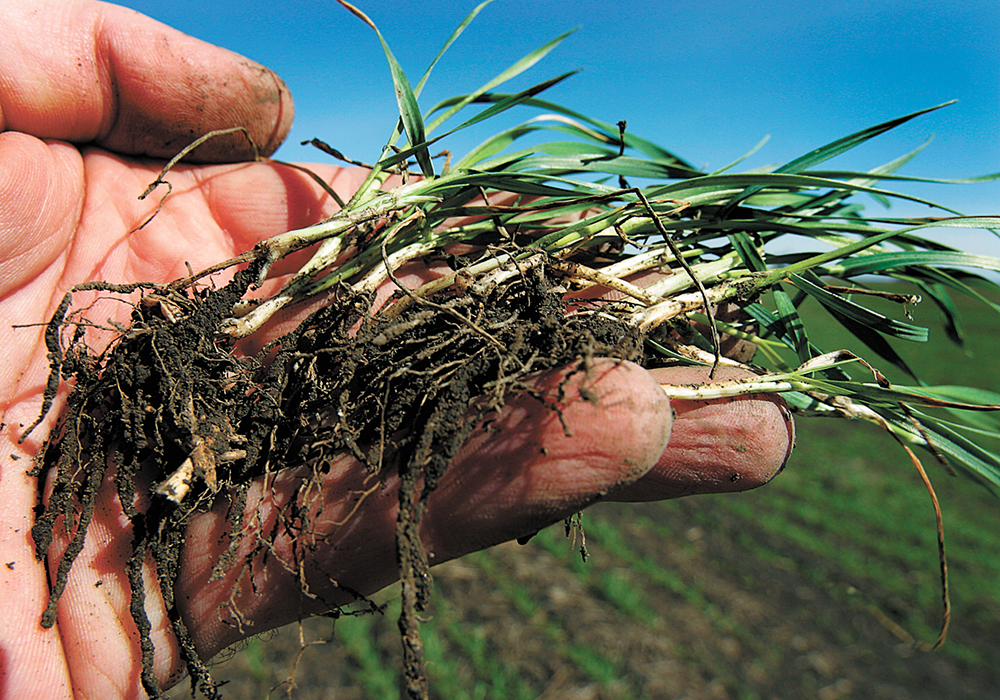Scientists determine that plants appear to influence the abundance of thousands of co-existing nuclei in their fungi
Many examples of symbiotic relationships between organisms exist in nature.
One of the best known is that of plants and root fungi, or arbuscular mycorrhizal fungi (AMF). The fungus colonizes the root system of a host plant and provides increased water and nutrients, while the plant provides the fungus with carbohydrates formed from photosynthesis.
Researchers at the University of Ottawa have now discovered that plants may actually control the genetics of these useful root fungi.
“Around four years ago, we discovered that some strains carry hundreds of nuclei in their cells that originate from two distinct parents,” said Nicolas Corradi, associate professor in the Department of Biology and Research Chair in Microbial Genomics.
Read Also

New wheat varieties offer Prairie farmers jump in yield
Three experimental wheat varieties developed by Agriculture Canada are showing yield increases of eight to 15 per cent over AAC Brandon wheat in registration trials.
“The next question was to try to understand if having two distinct genotypes was actually biologically relevant, which led to our recent discovery.”
The discovery is remarkable in that the scientists are able to demonstrate two benefits to both the plant and the fungi. One benefit is that the plant appears to influence the relative abundance of thousands of co-existing nuclei in the fungi. The second is that the multiple nuclei with different genetic backgrounds co-operate, rather than compete with one another, which potentially maximizes growth for both organisms.
Typically, a cell has one nucleus, although several fungi and some organisms can sometimes carry many nuclei per cell. But why AMF have thousands is still a mystery.
Corradi said that in some strains, two nuclear genotypes co-exist in one cell, which is believed to be the result of sexual reproduction. These fungus strains are known as AMF dikaryons.
“There is evidence that these can modify their ratios in response to the environment,” he said. “What is unique in our study are the large amounts of nuclei — we talk hundreds of thousands, theoretically — that are affected by this process.”
He added that each genotype may carry specific genes, and these encode for proteins that may be beneficial for the plant host, depending on the environmental conditions.
“Our findings suggest that change in the relative abundance of each genotype results in the production of more proteins from one genotype and less from the other, which could indicate a preferential ‘proteic’ (protein) treatment from the fungus depending on the plant’s needs.”
To understand the profile of AMF spores, the team implemented a novel molecular approach together with advanced microscopy and mathematical modelling.
“By analyzing single spores, we were able to quantify the genetics of thousands of nuclei and define their relative abundance in different fungal strains and across plant species,” Vasilis Kokkoris, a postdoctoral fellow in Corradi’s lab, said in the news release. “To ensure that we accurately analyze single nuclei, we used advanced microscopy to visualize and count the nuclei in the spores. We used mathematical modelling to prove that the observed abundance of nuclear genotypes we identified cannot be a product of luck but instead is the result of a driven co-operation between them.”
To better understand what is regulating the AMF nuclei, Kokkoris said that they grew different AMF strains of the fungi with different hosts and found that plants have control of the relative abundance of the fungal nuclei.
“For many years, AMF have been considered to be genetic peculiarities and far away from model organisms,” said Corradi. “Inconsistencies are commonly observed in plant-AMF experiments. For example, growing the same fungal strain with different plants can lead to drastically different plant yields. For a long time, this variance in plant growth was blamed on the AMF mysterious genetics.”
He said the research has provided answers as they demonstrate that the fungi’s genetics, and their impact on plant growth, can actually be manipulated by plants, thereby explaining the reason for the observed variabilities of plant growth. But how the plant actually controls the genetics of the fungi is still a mystery.
“This is unknown,” said Corradi. “But it could involve molecules that are known to play a role in host-microbe (interactions).”
Exactly how the host plant influences the abundance of the nuclei continues to be tested, especially as it relates to crop production and whether the plants’ influences lead to greater yield.
“That’s what we need to find out,” he said. “To this end, we have started several experiments that will show how having two distinct genotypes can help the plants grow better.”
The findings result from a collaboration with other scientists at Agriculture Canada, University of Ottawa and University of Montreal.
The research study was published in Current Biology.















